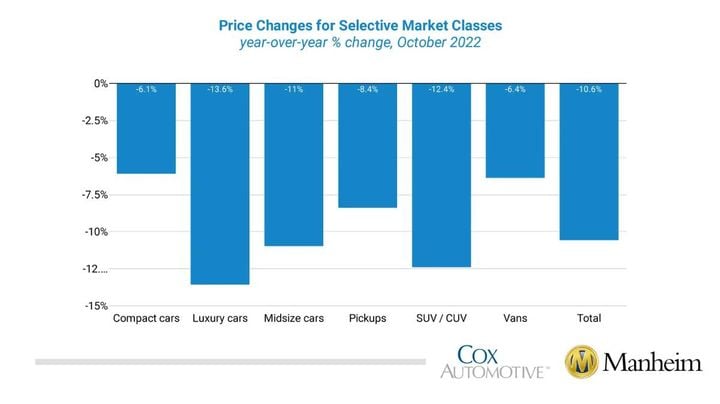
Compact cars had the smallest decline, at 6.1%, followed by vans and pickups, at 6.4% and 8.4%, respectively.
Graphic: Cox / Maheim
Wholesale used-vehicle prices (on a mix, mileage, and seasonally adjusted basis) decreased 2.2% in October from September, according to the Manheim Used Vehicle Value Index released Nov. 7. The index declined to 200.0 and is now down 10.6% from a year ago. The non-adjusted price change in October was a decline of 2.1% compared to September, moving the unadjusted average price down 9.3% year over year.
In October, Manheim Market Report (MMR) values saw smaller-than-normal declines that were relatively stable over the month, culminating in a 2.2% total decline in the Three-Year-Old Index over the last four weeks. In October, daily MMR Retention, which is the average difference in price relative to current MMR, averaged 98.2%, meaning market prices were below MMR values. The average daily sales conversion rate increased to 51.8%, which was above normal for the time of year. For example, the sales conversion rate averaged 49.3% in October 2019. The higher conversion rate indicated that the month saw sellers with more bargaining power than what is typically seen for this time of year.
All eight major market segments saw seasonally adjusted prices that were lower year over year in October. Compact cars had the smallest decline, at 6.1%, followed by vans and pickups, at 6.4% and 8.4%, respectively. Sports cars’ prices were just above the industry, while the remaining four segments’ prices were lower. Compared to September, six of eight major segments’ performances were down. Sports cars lost the most at 3.2%, followed by luxury cars at 2.7%. Four other segments lost between 2.4% and 0.8%. Full-size cars were up 4.5%, and vans were flat at 0.0%.
Used Retail Sales Estimates Declines in October
Leveraging a same-store set of dealerships selected to represent the country from Dealertrack, Manheim initially estimates that used retail sales declined 9% in October from September and that used retail sales were down 13% year over year. Compared to October 2019, sales were down 32%, which was the worst monthly comparison so far this year. Credit transactions heavily influence the same-store data series, and growth in cash purchase activity is likely causing the estimates to decline more than actual market sales. Nevertheless, used sales momentum likely faded in October.
Using estimates of used retail days’ supply based on vAuto data, October ended at 49 days of supply, down from 52 days at the end of September but higher than how October 2021 ended at 40 days. Leveraging Manheim sales and inventory data, wholesale supply is estimated to have ended October at 28 days, higher than how October 2021 ended at 20 days but unchanged from the end of September.
October’s total new-light-vehicle sales were up 9.6% year over year, with one less selling day than in October 2021. By volume, October new-vehicle sales were up 2.9% from September. The October sales pace, or seasonally adjusted annual rate (SAAR), came in at 14.9 million, a 12.7% increase from last year’s 13.2 million and up 9.8% from September’s 13.6 million pace.
Combined sales into large rental, commercial, and government fleets were up nearly 49% year over year in October. Sales into rental were up 58% year over year, while sales into commercial fleets were also up 58% and sales into government fleets were virtually flat. Including an estimate for fleet deliveries into dealer and manufacturer channels, the remaining retail sales were estimated to be up 5.9%, leading to an estimated retail SAAR of 12.8 million, up 0.9 million from last month’s pace, or 7.4%, and up 1.2 million, or 10.3%, from last year. The fleet share of 14.1% was up 1.9% from last month and was up 2.9% from last year.
Rental Risk Prices Declines Significantly in October
The average price for rental risk units sold at auction in October was down 5.2% year over year. Rental risk prices were down 4% compared to September. Average mileage for rental risk units in October (at 56,500 miles) was down 6.9% compared to a year ago but up 4.3% from September.
Measures of Consumer Confidence Mixed in October
The Conference Board Consumer Confidence Index declined 4.9% in October when a smaller 1.9% decline had been expected, and the September index was also revised down. Most of the index decline was driven by a 7.5% decline in views of the present situation. Plans to purchase a vehicle in the next six months rebounded strongly to the highest level since July 2020 and was up substantially year over year. The confidence index has not declined as much this year as the sentiment index from the University of Michigan, but that series improved in October. The Michigan index increased 2%, but its’ underlying measures moved in different directions, with views of current conditions improving and expectations declining. The daily Index of Consumer Sentiment from Morning Consult declined 2.7% in October as both underlying measures of current conditions and future expectations declined. Stock market volatility and mid-term election rhetoric likely weighed on the observed declines.
Originally posted on Vehicle Remarketing
